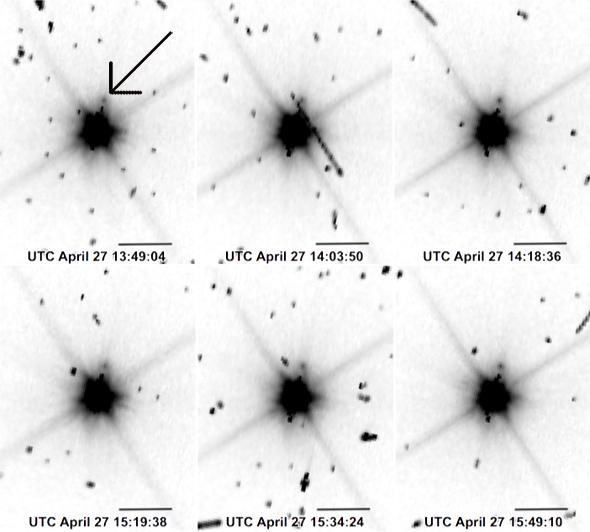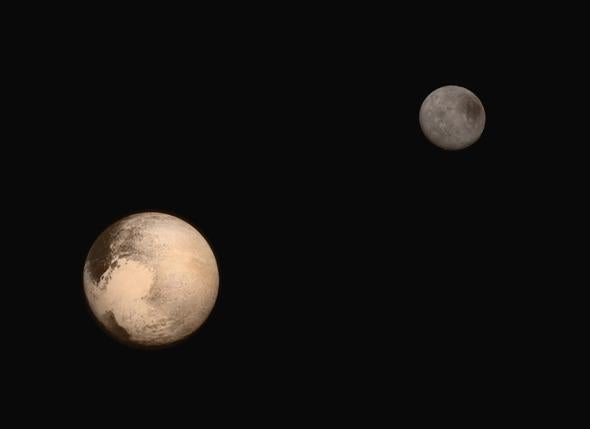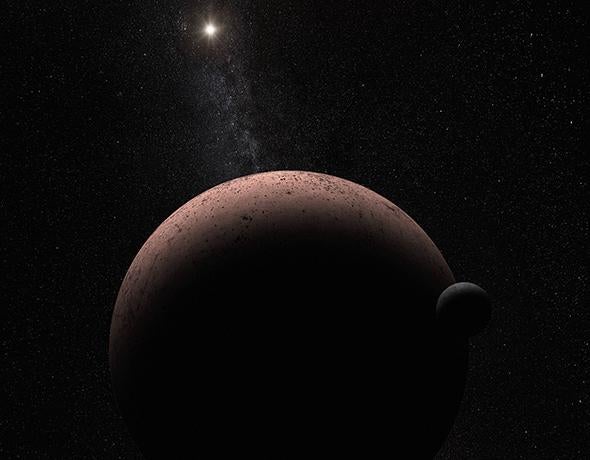Well now, this is very cool: Astronomers have just announced that Makemake has a moon!
Makemake (pronounced MAH-kay-mah-kay; it’s named after a Rapa Nui god who created humanity) is a Kuiper Belt object (or KBO), a large icy world orbiting the Sun way out past Neptune. It’s what’s called a “classical” KBO, because its orbit is far enough from Neptune’s that it can orbit the Sun stably for billions of years (Pluto actually gets closer to the Sun than Neptune does, but their orbits are timed such that they never get very close together). At 1,430 kilometers across, it’s the biggest known classical KBO, and the third biggest such body known past Neptune. Only Pluto and Eris are bigger.
We know quite a bit about Makemake from previous observations. It takes about 7.77 hours to rotate once, and must have a very reflective surface. Spectra show it has a lot of frozen methane on it, too, more than any other object out past Neptune. Its orbit is elliptical, taking it as close to the Sun as 5.8 billion kilometers and as far as 7.9 billion kilometers out. Right now it’s almost at aphelion, the point in its orbit when it’s farthest from the Sun.
It’s been observed many times, but until now no moon had been found. The discovery was made using Hubble Space Telescope, which observed Makemake exactly one year ago, on April 27, 2015. The moon—which for now has the cumbersome designation S/2015 (136472) 1—was seen very close to the KBO, almost lost in its glare.
That may be why it hasn’t been seen before. For one thing, it’s much fainter than Makemake, making it hard to detect. The astronomers who discovered it also propose that we may be seeing its orbit edge-on, which means it spends much of its time too close to Makemake to easily detect from Earth. From its brightness it’s probably very roughly 200 kilometers in diameter, so seeing it at all is remarkable, especially from more than 7 billion kilometers away!

Parker, et al.
The observations were split into two “visits”; one on April 27 and the next on April 29. The moon was seen in the first visit but not the second, meaning it was too close to Makemake to see in the second set. Each visit consisted of six long exposures, and the moon was seen in all six images on the first visit.
The problem is the time between the first and last images in the first visit was only a couple of hours, which was not enough to show any motion of the moon. That means the orbit isn’t well-known. The best the astronomers could do was say that the orbital distance is at least 21,000 kilometers, but may be as much as 300,000! For comparison, the Moon orbits the Earth at a distance of about 380,000 kilometers. The moon orbits Makemake with a period somewhere between 12 and 660 days.
Those are pretty wide ranges. And that’s too bad, because the orbit of a moon is really critical: It tells you the mass of the object it orbits. Gravity depends on mass of the primary object and the distance to the moon, so if the orbital period of S/2015 (136472) 1 had been measured, the mass of Makemake could have been found.
What makes this even more frustrating is that we know how big Makemake is, because in 2011 it passed directly in front of a star as seen from Earth; the length of time it blocked the star combined with its known orbital speed yielded the diameter of 1,430 kilometers. With that number, plus the mass, its density could be determined, and that gives a huge clue about what it’s made of. Rock is denser than ice, for example, so just knowing Makemake’s density would constrain its composition.
However, the good news is that now that we know the moon exists, more observations can be made. It may take Hubble to see it once again—Hubble’s really good at spotting faint things near bright things—but it can be done. And if carefully planned (which it will be), the moon’s orbital period and shape can be found.
There are some interesting implications of this, too. Earlier infrared observations of Makemake indicated the surface had at least two different materials on it, which had different thermal properties (darker material, for example, gets warmer than more reflective stuff). If that were the case, though, the brightness of Makemake should change enough to measure as it spins, but no such change was seen.
The moon may solve this problem! If it’s darker than Makemake, then that would throw off the infrared observations. Those telescopes couldn’t separate the moon and the KBO, so they merged together, confusing the interpretation.

NASA/JHUAPL/SwRI/Phil Plait
I find that very interesting indeed. As you may remember from last year, Charon, Pluto’s moon, is much darker than Pluto as well. If this new moon is indeed dark, that might indicate a similar origin story. Future observations with the James Webb Space Telescope, due to launch in 2018, may help figure this all out; it has the keen vision in the infrared to separate the two objects and determine how reflective the moon is.
Just the fact that the moon exists is interesting, too. Pluto has a moon, as does Eris and Haumea (another large trans-Neptunian object a bit smaller than Makemake). Are they ubiquitous? Two other such objects, Sedna and 2007 OR10*, have no known moons. Perhaps we just haven’t seen them because they’re too close to their primaries. Clearly, more and deeper observations are needed.
And let’s not lose sight of the more general nature of this: We’re still learning basic information about our solar system! Finding a moon like this gives precious insight into what the outskirts of our celestial neighborhood are like, a region that is terribly far away and dark, and very difficult to explore. Each discovery about it is a clue to how it came to be, how it changed over time, and why it looks the way it does now.
All of this tells us more about our existence, and informs us about our own world. A cold and distant moon orbiting a smallish ice ball may not seem like much, but it’s another piece of the puzzle, one worth investigating and understanding.
* Correction, April 27, 2016: I orginally wrote that object’s name as 2010 OR10.
